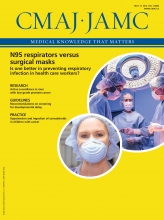See also page 598 and www.cmaj.ca/lookup/doi/10.1503/cmaj.150663
Dementia is a clinical diagnosis
Patients presenting with suspected cognitive decline should undergo a detailed history, physical examination and cognitive screening to establish functional impairment.1 Laboratory investigations to rule out medical causes of cognitive impairment, such as hypothyroidism, anemia, electrolyte abnormalities, vitamin-B12 deficiency and hyperglycemia, should be initiated. Diagnostic criteria as defined by clinical guidelines has shown a high sensitivity (81%) but lower specificity (70%) for Alzheimer disease.2
Anatomic imaging is the first-line imaging modality in dementia
Computed tomography (CT) of the head is recommended for patients with specific features at presentation (Box 1). Magnetic resonance imaging is more sensitive than CT in detecting atrophy and small-vessel disease, including lobar microbleeds (an index of Alzheimer disease pathology) and may be used to stratify and monitor disease severity.1–3
Indications for computed tomography in patients with cognitive decline*
Age < 60 yr
Rapid decline in cognition or function (1–2 mo)
Duration of dementia < 2 yr
Recent head trauma
New unexplained neurologic symptoms or localizing signs
History of cancer
Use of anticoagulants or history of bleeding disorder
History of gait disorder or urinary incontinence early in dementia
Atypical cognitive symptoms or presentation
Current gait disturbance
Nuclear medicine brain scans can be useful in atypical dementia
Perfusion imaging of the brain with a technetium-99m–labelled radiotracer and single-photon emission computed tomography (SPECT) can be helpful in patients with atypical dementia, including early-onset or rapidly progressing dementia, as well as patients with unknown cause of dementia after baseline investigations.1,2 SPECT is safe and noninvasive, with effective radiation doses similar to those of CT of the head.4
Positron emission tomography may be helpful to evaluate brain metabolism or amyloid deposition
Imaging of brain metabolism with positron emission tomography (PET) using fluorine-18–labelled fluorodeoxyglucose is generally superior to perfusion imaging with SPECT for differentiating dementia subtypes, such as Alzheimer disease and Lewy body dementia, and can influence management.5 Amyloid deposition may be detected with PET using fluorine-18–labelled florbetapir, flutemetamol or florbetaben. Recently, PET has also been used to identify the presence of tau protein. In Canada, PET of the brain is currently available in some tertiary centres for clinical use or for clinical research trials.
Cerebrospinal fluid biomarkers are used for investigational purposes
Apart from ruling out infectious or autoimmune causes, cerebrospinal fluid (CSF) biomarkers, such as low CSF amyloid-β 42 and high tau levels, are available for use in investigational studies and clinical trials, and as optional clinical tools.
Footnotes
Competing interests: Sandra Black declares personal fees and/or grants from Pfizer, GE Healthcare, Eli Lilly, Eisai, Boehringer Ingelheim, Novartis, Elan and Transition Therapeutics, Roche and Cognoptix. No other competing interests were declared.
This article has been peer reviewed.











